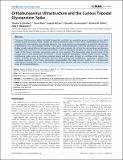Files in this item
Orthobunyavirus ultrastructure and the curious tripodal glycoprotein spike
Item metadata
| dc.contributor.author | Bowden, Thomas A. | |
| dc.contributor.author | Bitto, David | |
| dc.contributor.author | McLees, Angela | |
| dc.contributor.author | Yeromonahos, Christelle | |
| dc.contributor.author | Elliott, Richard M. | |
| dc.contributor.author | Huiskonen, Juha T. | |
| dc.date.accessioned | 2014-07-16T14:31:10Z | |
| dc.date.available | 2014-07-16T14:31:10Z | |
| dc.date.issued | 2013-05-16 | |
| dc.identifier | 131417313 | |
| dc.identifier | 7f100fe8-8b05-4c9e-a68d-02e3e267f7d3 | |
| dc.identifier | 000320032800047 | |
| dc.identifier | 84878490025 | |
| dc.identifier.citation | Bowden , T A , Bitto , D , McLees , A , Yeromonahos , C , Elliott , R M & Huiskonen , J T 2013 , ' Orthobunyavirus ultrastructure and the curious tripodal glycoprotein spike ' , PLoS Pathogens , vol. 9 , no. 5 , e1003374 . https://doi.org/10.1371/journal.ppat.1003374 | en |
| dc.identifier.issn | 1553-7374 | |
| dc.identifier.uri | https://hdl.handle.net/10023/5031 | |
| dc.description | This work was supported by the Wellcome Trust (090532/Z/09/Z; 089026/Z/09/Z to TAB; 079810 to RME) and by the Academy of Finland (130750 and 218080 to JTH). | en |
| dc.description.abstract | The genus Orthobunyavirus within the family Bunyaviridae constitutes an expanding group of emerging viruses, which threaten human and animal health. Despite the medical importance, little is known about orthobunyavirus structure, a prerequisite for understanding virus assembly and entry. Here, using electron cryo-tomography, we report the ultrastructure of Bunyamwera virus, the prototypic member of this genus. Whilst Bunyamwera virions are pleomorphic in shape, they display a locally ordered lattice of glycoprotein spikes. Each spike protrudes 18 nm from the viral membrane and becomes disordered upon introduction to an acidic environment. Using sub-tomogram averaging, we derived a three-dimensional model of the trimeric pre-fusion glycoprotein spike to 3-nm resolution. The glycoprotein spike consists mainly of the putative class-II fusion glycoprotein and exhibits a unique tripod-like arrangement. Protein-protein contacts between neighbouring spikes occur at membrane-proximal regions and intra-spike contacts at membrane-distal regions. This trimeric assembly deviates from previously observed fusion glycoprotein arrangements, suggesting a greater than anticipated repertoire of viral fusion glycoprotein oligomerization. Our study provides evidence of a pH-dependent conformational change that occurs during orthobunyaviral entry into host cells and a blueprint for the structure of this group of emerging pathogens. | |
| dc.format.extent | 10 | |
| dc.format.extent | 5356197 | |
| dc.language.iso | eng | |
| dc.relation.ispartof | PLoS Pathogens | en |
| dc.subject | La-crosse-virus | en |
| dc.subject | Valley fever virus | en |
| dc.subject | EM structure determination | en |
| dc.subject | Membrane-fusion proteins | en |
| dc.subject | Electron-microscopy | en |
| dc.subject | Cryoelectron tomography | en |
| dc.subject | Envelope glycoprotein | en |
| dc.subject | Schmallenberg virus | en |
| dc.subject | Oropouche virus | en |
| dc.subject | Uukuniemi virus | en |
| dc.subject | QR355 Virology | en |
| dc.subject | SDG 3 - Good Health and Well-being | en |
| dc.subject.lcc | QR355 | en |
| dc.title | Orthobunyavirus ultrastructure and the curious tripodal glycoprotein spike | en |
| dc.type | Journal article | en |
| dc.contributor.sponsor | The Wellcome Trust | en |
| dc.contributor.institution | University of St Andrews. School of Biology | en |
| dc.contributor.institution | University of St Andrews. Biomedical Sciences Research Complex | en |
| dc.identifier.doi | https://doi.org/10.1371/journal.ppat.1003374 | |
| dc.description.status | Peer reviewed | en |
| dc.identifier.grantnumber | 079810/Z/06/Z | en |
This item appears in the following Collection(s)
Items in the St Andrews Research Repository are protected by copyright, with all rights reserved, unless otherwise indicated.

